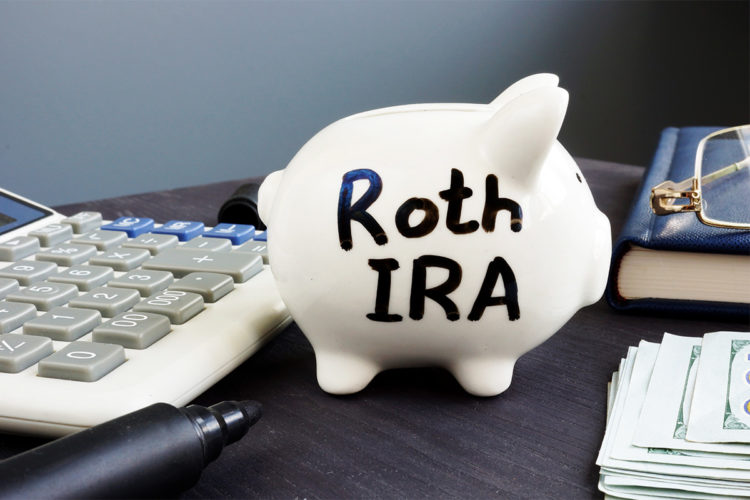When to Consider a Roth IRA Conversion

Sometimes life events, such as launching a new business, can mean a temporary reduction in household income. During times when you are earning less, consider putting a Roth IRA conversion strategy in place.
How Does a Roth IRA work?
A Roth IRA conversion occurs when you transfer assets from a pre-tax traditional IRA into a post-tax Roth IRA. This strategy may allow you to pay lower taxes at the time of conversion than what you may have to pay during your retirement years.
While a Roth conversion can be done anytime, conversions can be particularly attractive in years when household income is temporarily lower or eliminated.
For example, if a married couple filing jointly with $450,000 of taxable income experienced a temporary drop in income one year to $100,000, their marginal tax rate1 would go from 35% to 22%. They could potentially take advantage of their decline in income by converting roughly $50,000 of their traditional IRA into a Roth IRA at the 22% marginal tax rate.
Another advantage Roth IRAs have compared to traditional IRAs is that they grow tax free versus tax deferred. You can make qualified, federal-income- tax-free withdrawals from the Roth IRA as long as you follow the five-year waiting rule, which applies to three situations: if you withdraw account earnings, if you convert a traditional IRA to a Roth, and if a beneficiary inherits a Roth IRA.2
Roth IRAs are not subject to required minimum distributions (RMDs) during an individual’s lifetime, so it could be an asset that you leave to your heirs, assuming you have the funds needed for your retirement.
The following list highlights a few life events that may make exploring a Roth conversion worthwhile:
- Job Loss – If you lose your job, finding another one could take months, or longer, especially for high-income earners. The temporary elimination of earnings could mean it’s the right time to convert to a post-tax Roth IRA. Of course, it’s important to ensure that you have sufficient cash reserves to cover your expenses while you are looking for your next position.
- Starting a Business – Launching a new business could temporarily reduce your income. Again, as long as you have sufficient cash reserves, it could be a great time to do a Roth IRA conversion.
- Having a Bad Year – For example, if you are in sales, you may have a highly variable compensation structure in which your income increases during great years but drops during lean years. Those down years may be more tolerable if you save on your future tax bill with a Roth IRA conversion.
- Early Retirement – Retiring in your 60s or sooner? If so, you may have an opportunity to shift funds from pre-tax retirement accounts into a Roth IRA. Since Social Security benefits and required minimum distributions from pre-tax IRAs may increase your income and potentially your tax bracket at age 70½ (assuming you delay IRA distributions and Social Security benefits until then), the time between your last paycheck and age 70½ may be an optimal time for post-tax Roth conversions.
Two Ways to Handle Taxes on the Conversion
The funds that you convert from a traditional IRA to a Roth IRA are treated as a taxable distribution in the calendar year of the conversion. You can pay the taxes before or after conversion. If you have sufficient cash reserves outside of your IRA accounts to pay taxes due after the conversion, you will keep your retirement account intact, which allows for more tax-free growth in the Roth IRA.
Your other option would be to withhold taxes from the traditional IRA funds prior to the conversion so that the money transfers to the Roth IRA net of taxes. For example, when converting $50,000, if your marginal tax rate is 22%, then you would withhold $11,000 and have a net conversion of $39,000. The advantage is that you wouldn’t need to have cash available to pay taxes — they would come out of the traditional IRA distribution.
We’ll Advise You on a Tax Strategy
Mariner can help you evaluate your circumstances and determine whether a Roth IRA conversion or other tax strategy may be right for you.
Sources:
1According to “Effective Tax Rate vs. Marginal Tax Bracket: What You Need to Know,” The Motley Fool, April 8, 2017, “Marginal tax rates” apply to the tax rate you pay on your last dollar of income, not your entire taxable income. For example, if you are married filing jointly with an income of $450,000, you pay 10% on the first $19,400, and so on, until you only pay 35% (highest percentage) on part of the income from $408,201 to $450,000, so different marginal tax rates can be applied to your income. The effective tax rate, however, is the actual percentage of your income that you will pay to the IRS and is often significantly lower than your marginal tax bracket.
2“What is the Roth 5-Year Rule?”
Roth IRA Conversions are complex and treatment depends on the type of IRA that is being converted to a Roth IRA. The views expressed regarding Roth Conversions are for commentary purposes only and do not take into account any individual personal, financial, or tax considerations. It is not intended to be a solicitation to buy or sell or engage in a particular investment strategy. Before initiating a Roth IRA Conversion, please consult with a financial or tax professional and ensure you consider all your available options, including applicable taxes, fees and features.
If you convert a Traditional IRA to a Roth IRA, the amount of the conversion will be treated as a distribution for income tax purposes and is includible in your gross income (excluding any nondeductible contributions). Although the conversion amount generally is included in income, the 10% early distribution penalty tax will not apply to these conversions, regardless of whether you qualify for any exceptions to the 10% early distribution penalty tax. If you are required to take a required minimum distribution (RMD) for the year, you must remove your RMD before converting to a Roth IRA.
Mariner is the marketing name for the financial services businesses of Mariner Wealth Advisors, LLC and its subsidiaries. Investment advisory services are provided through the brands Mariner Wealth, Mariner Independent, Mariner Institutional, Mariner Ultra, and Mariner Workplace, each of which is a business name of the registered investment advisory entities of Mariner. For additional information about each of the registered investment advisory entities of Mariner, including fees and services, please contact Mariner or refer to each entity’s Form ADV Part 2A, which is available on the Investment Adviser Public Disclosure website. Registration of an investment adviser does not imply a certain level of skill or training.
